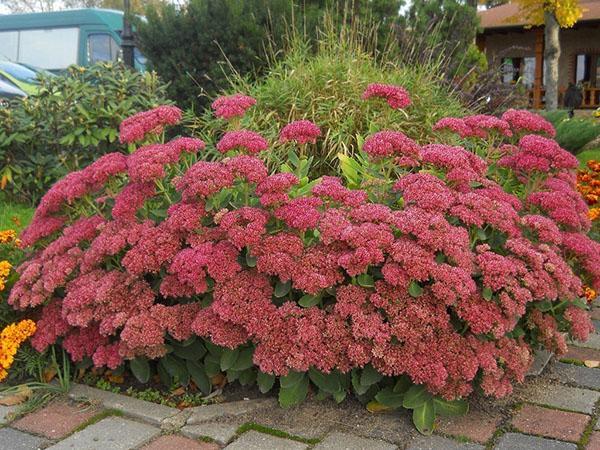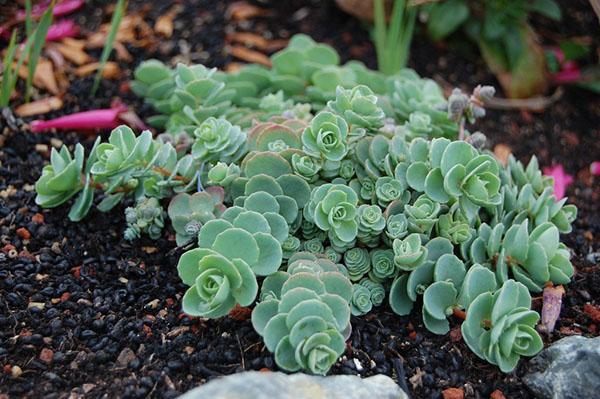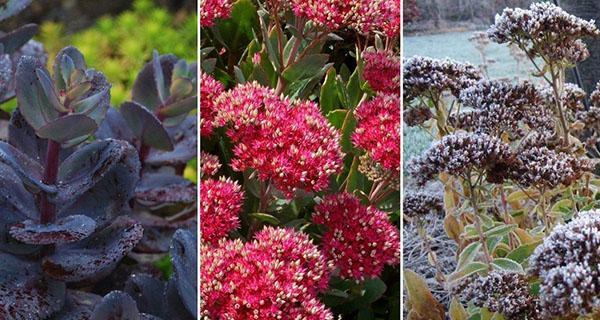Types and varieties of sedum for exquisite landscaping of a summer cottage
 Fans of green spaces often use various types and varieties of sedum in their flower beds. This humble succulent is sometimes called sedum, which is Latin for “to calm down” or “sit”. In ancient times, some plant species were used by folk healers as a means to relieve pain symptoms. To this day, its leaves are applied to burns or cuts.
Fans of green spaces often use various types and varieties of sedum in their flower beds. This humble succulent is sometimes called sedum, which is Latin for “to calm down” or “sit”. In ancient times, some plant species were used by folk healers as a means to relieve pain symptoms. To this day, its leaves are applied to burns or cuts.

A special advantage of the flower is its simple reproduction (by cuttings, shoots) and survival on any soil, even poor in minerals.
Types and varieties of sedum through the eyes of gardeners
 Until a few years ago, it was believed that there were at least about 500 different types of sedum. But thanks to the unpretentiousness of this plant, more and more options appear that decorate the country landscapes. Consider the most popular types and varieties of stonecrop, which amaze with their elegance and modest beauty.
Until a few years ago, it was believed that there were at least about 500 different types of sedum. But thanks to the unpretentiousness of this plant, more and more options appear that decorate the country landscapes. Consider the most popular types and varieties of stonecrop, which amaze with their elegance and modest beauty.
Lydian
 The plant is a perennial succulent of evergreen character. It is used as a ground cover element of landscape design. It has short (about 6 cm) shoots, which are covered with narrow needle-like leaves. Most often they are colored bluish-blue. Interestingly, the basal leaf platinum has a slightly reddish tint.
The plant is a perennial succulent of evergreen character. It is used as a ground cover element of landscape design. It has short (about 6 cm) shoots, which are covered with narrow needle-like leaves. Most often they are colored bluish-blue. Interestingly, the basal leaf platinum has a slightly reddish tint.
 The sedum Lydian blooms in the last decade of June. On it, miniature white-pink buds appear on low pedicels. Often there are not very many of them, but the plant looks spectacular against the background of other garden plants. It is planted near the sidewalks; as background plant on alpine coaster and an unsurpassed living carpet at the summer cottage.
The sedum Lydian blooms in the last decade of June. On it, miniature white-pink buds appear on low pedicels. Often there are not very many of them, but the plant looks spectacular against the background of other garden plants. It is planted near the sidewalks; as background plant on alpine coaster and an unsurpassed living carpet at the summer cottage.
Because this blue sedum is drought-resistant, it should not be grown in small containers or in areas that are too sunny.
White
 In its natural environment, the plant is found in Russia, North Africa, Western Europe and the Caucasus. The species got its name for the exquisite color of fragrant buds. They rise above the green in the form of paniculate inflorescences.
In its natural environment, the plant is found in Russia, North Africa, Western Europe and the Caucasus. The species got its name for the exquisite color of fragrant buds. They rise above the green in the form of paniculate inflorescences.
Sedum White is considered a perennial plant that forms earthy rugs about 8 cm high. It is often planted along garden paths or next to tall trees. Gardeners grow different varieties of sedum to beautify flower beds. Let's note just a few popular options:
- Coral Carpet;

- Hillebrandty;

- Faro Forum.

If such a sedum is grown in partial shade, its leaves will be colored dark green. In open areas, they take on a reddish tint. It is for this plant that it is widely used to form alpine slides and low flower beds.
Hybrid
 This perennial evergreen plant forms wonderful living rugs approximately 15 cm high.It perfectly tolerates winter cold and frost. Sedum Hybrid blooms in early August with bright yellow buds, towering about 25 cm above the rug. The variety is not afraid of dry periods, therefore it never loses its pristine freshness and beauty.
This perennial evergreen plant forms wonderful living rugs approximately 15 cm high.It perfectly tolerates winter cold and frost. Sedum Hybrid blooms in early August with bright yellow buds, towering about 25 cm above the rug. The variety is not afraid of dry periods, therefore it never loses its pristine freshness and beauty.
The original property of the plant is to stand for a long time in a container with water, which allows you to decorate the living space with stylish green rugs.
Caucasian
 Sedum (sedum) of this species was named after the place of its growth in the natural environment. Huge dense thickets of succulent cover the rocky cliffs and spacious meadows of the Caucasus. Despite extreme conditions, the plant has erect shoots, covered with many foliage of this color:
Sedum (sedum) of this species was named after the place of its growth in the natural environment. Huge dense thickets of succulent cover the rocky cliffs and spacious meadows of the Caucasus. Despite extreme conditions, the plant has erect shoots, covered with many foliage of this color:
- dark green;
- reddish;
- purple.
Sedum Caucasian blooms in late August with star-shaped snow-white buds. For a month and a half, you can admire this cute rug in the flower bed.
Given the peculiarity of the species, shedding leaves during flowering, it is advisable to grow it together with other plants. This will help hide the exposed stonecrop shoots.
Evers
 By the nature of growth, the species does not resemble a living green rug, but a cluster of bushes that grow by themselves. The height of each of them can reach about 40 cm. Its dense leaf plates are painted in a pale green color. Sometimes it has a bluish tint, which looks wonderful on a flower bed.
By the nature of growth, the species does not resemble a living green rug, but a cluster of bushes that grow by themselves. The height of each of them can reach about 40 cm. Its dense leaf plates are painted in a pale green color. Sometimes it has a bluish tint, which looks wonderful on a flower bed.
When the plant blooms, delicate buds appear on high pedicels. That is why the pink sedum Evers is planted on rocky alpine hills, rockeries or next to curbs.
Spanish
 The plant is characterized by a special ability to constant change:
The plant is characterized by a special ability to constant change:
- shape and color of leaf plates;
- flowering periods;
- the duration of growth on one piece of land.
 The Spanish sedum shown in the photo is widely used as a ground cover element in landscape design. Its height, on average, reaches 10 cm. On erect shoots are miniature gray-green or reddish leaves.
The Spanish sedum shown in the photo is widely used as a ground cover element in landscape design. Its height, on average, reaches 10 cm. On erect shoots are miniature gray-green or reddish leaves.
If sedum is grown in fertile soil, the leaf plates acquire a rich green color.
The first buds appear in mid-summer. On the territory of Russia, sedum dies off immediately after flowering. Despite this, the seeds of the plant have time to re-germinate in early autumn.
False blush
 Looking at photos with the names of varieties and types of stonecrop, many gardeners are surprised at their extraordinary diversity. These cute succulents form living rugs on the backyards of country houses. A special place is occupied by a low plant with rich green leaves, which, at the first frost, turn bronze or reddish. It is he who many lovingly call sedum False blush.
Looking at photos with the names of varieties and types of stonecrop, many gardeners are surprised at their extraordinary diversity. These cute succulents form living rugs on the backyards of country houses. A special place is occupied by a low plant with rich green leaves, which, at the first frost, turn bronze or reddish. It is he who many lovingly call sedum False blush.
When buds appear on a living rug at the beginning of summer, it causes an unprecedented delight. They can be of different colors, namely:
- snow-white;
- cream;
- raspberry;
- scarlet;
- dark red.
In addition, there are many varieties of False Sedum. Here is some of them:
- Erd Bluet;

- Bronze Carpet;

- "Rosea".

Lush bloom of stonecrop continues until August, without losing its attractiveness. The plant feels comfortable in open sunny areas. Some gardeners grow it in spacious containers.
Pink foam
 This variety appeared relatively recently and is considered a profusely flowering carpet plant. In July, when summer is in full swing, the sedum pink foam is covered with many bright buds. They resemble lush foam, for which they got their name. During this period, greenery is practically invisible, there are only delicate pink flowers around, which are harmoniously combined with other plants of the landscape.
This variety appeared relatively recently and is considered a profusely flowering carpet plant. In July, when summer is in full swing, the sedum pink foam is covered with many bright buds. They resemble lush foam, for which they got their name. During this period, greenery is practically invisible, there are only delicate pink flowers around, which are harmoniously combined with other plants of the landscape.
Kamchatka
 When growing this ground cover plant, it should be borne in mind that it does not tolerate drought. It must be watered regularly and a shaded area of the garden must be found for it.As a result, the flowering sedum will be covered with yellow buds until the end of August, turning into a lush living carpet. The most common varieties of Kamchatka stonecrop:
When growing this ground cover plant, it should be borne in mind that it does not tolerate drought. It must be watered regularly and a shaded area of the garden must be found for it.As a result, the flowering sedum will be covered with yellow buds until the end of August, turning into a lush living carpet. The most common varieties of Kamchatka stonecrop:
- Weichenstephaner Gold (has greenish-yellow inflorescences);

- Golden Carpet (bright yellow buds);

- Spotted sedum (foliage with a cream frame).

Sedum Kamchatsky does not tolerate open areas where there is a lot of sunlight. Because of this, its serrated leaf plates turn red, which adversely affects the decorative effect of the plant.
Pungent
 Yellow sedum Acid is found in various parts of the planet. Siberia, Canada, the Caucasus and Europe can rightfully be called his homeland. The plant is characterized by rounded shoots with many delicate twigs covered with fleshy foliage. The plates are arranged alternately, which gives the stonecrop a stylish look. They remain on the plant even in winter, so a flower bed or alpine slide does not lose its attractiveness all year round. During the flowering period, stonecrop is covered with numerous bright yellow buds. Truly, a bright sight in the flower bed!
Yellow sedum Acid is found in various parts of the planet. Siberia, Canada, the Caucasus and Europe can rightfully be called his homeland. The plant is characterized by rounded shoots with many delicate twigs covered with fleshy foliage. The plates are arranged alternately, which gives the stonecrop a stylish look. They remain on the plant even in winter, so a flower bed or alpine slide does not lose its attractiveness all year round. During the flowering period, stonecrop is covered with numerous bright yellow buds. Truly, a bright sight in the flower bed!